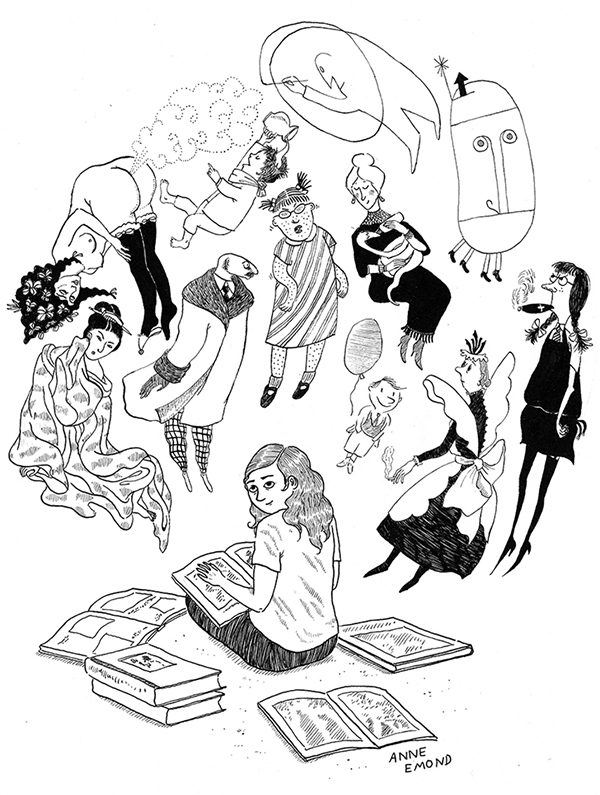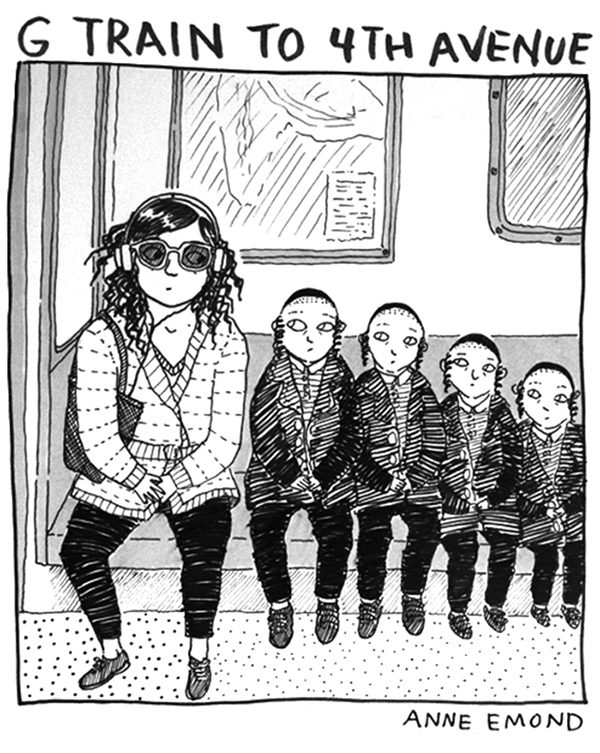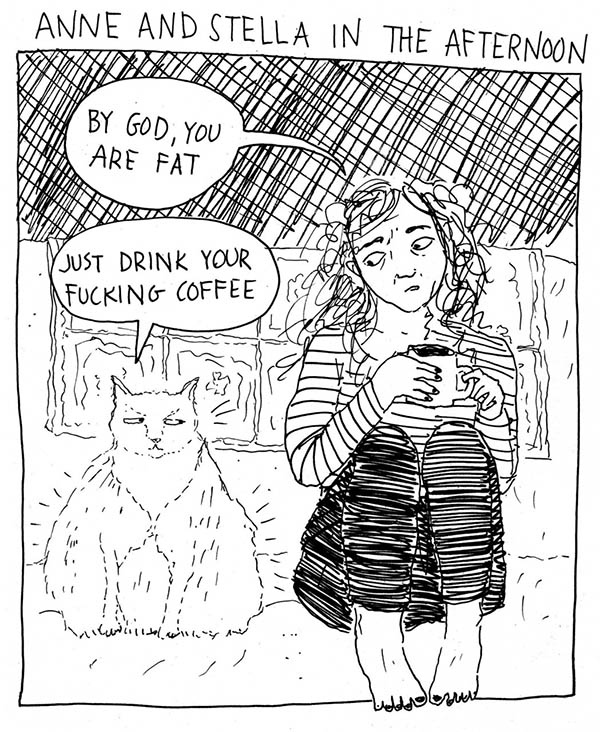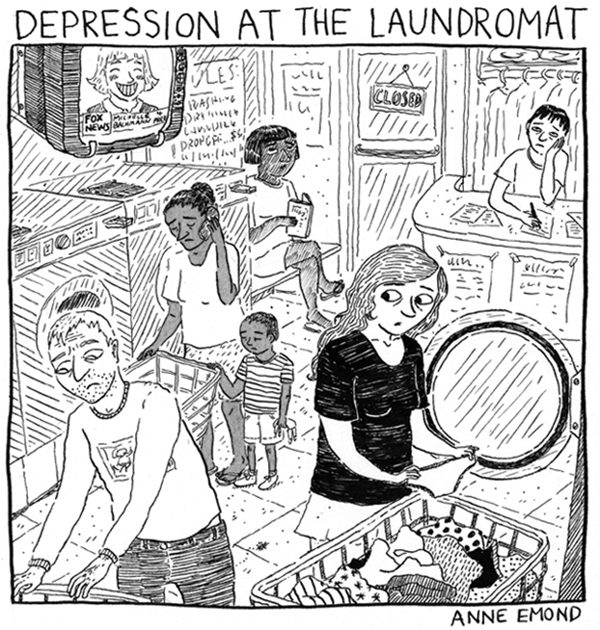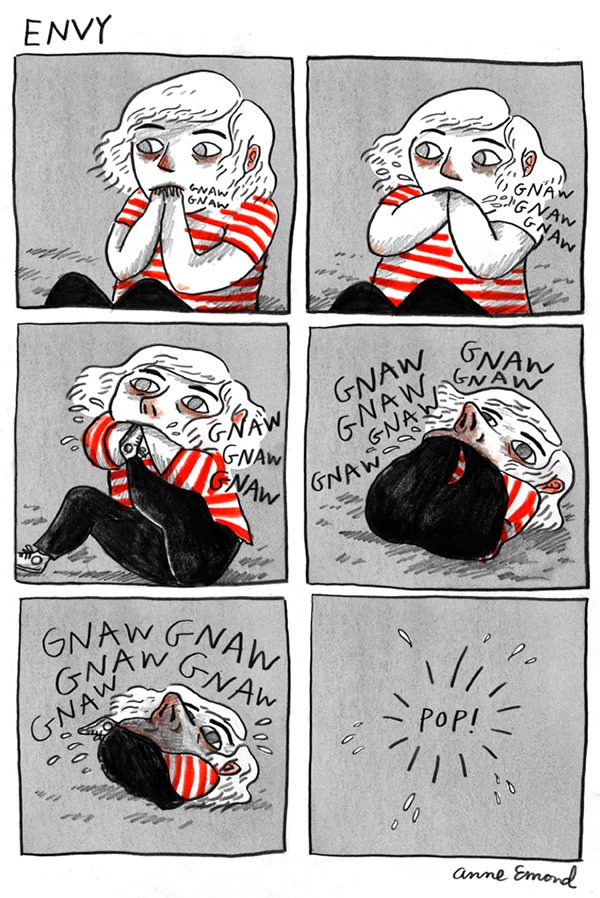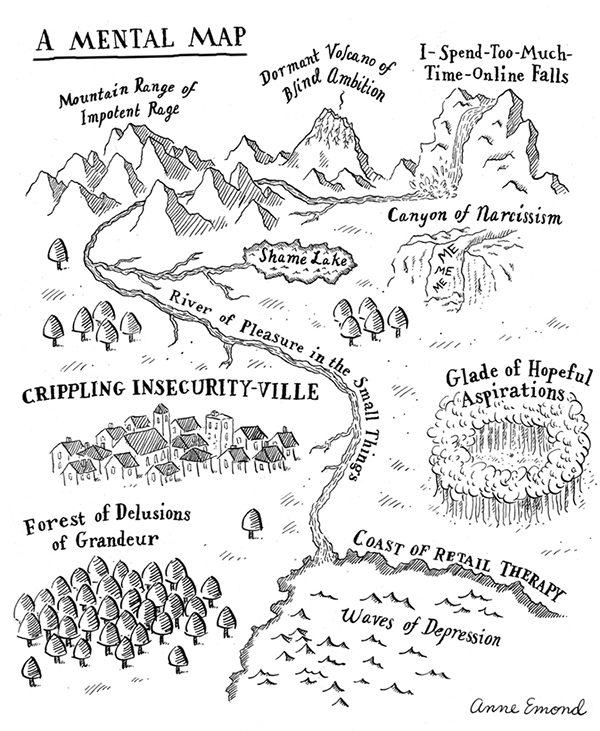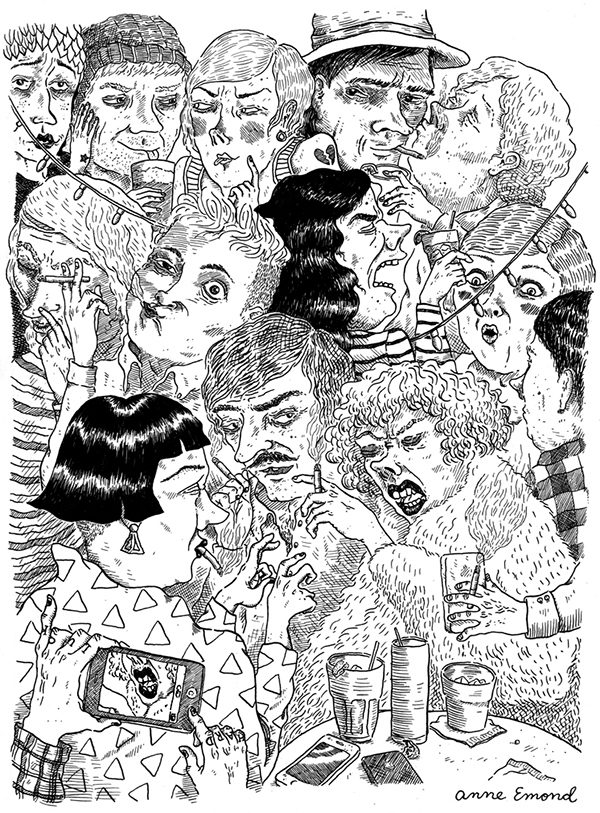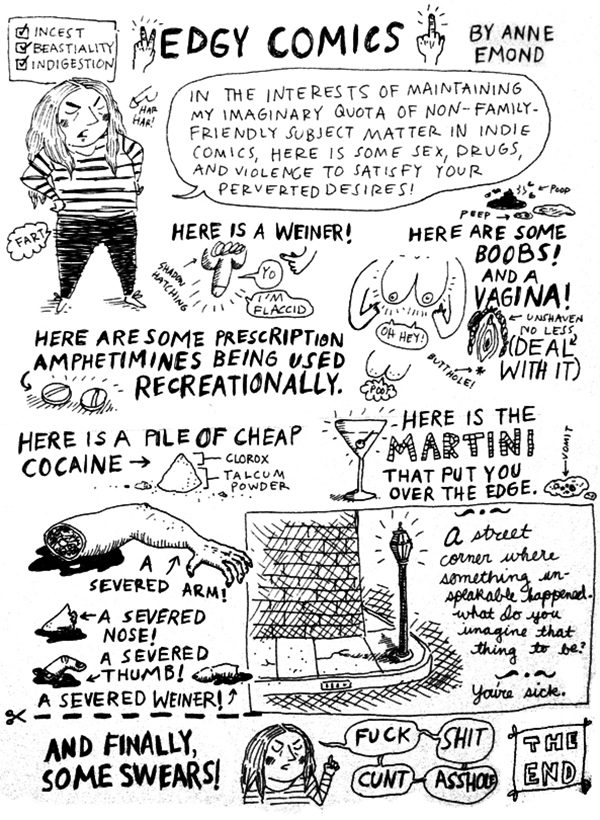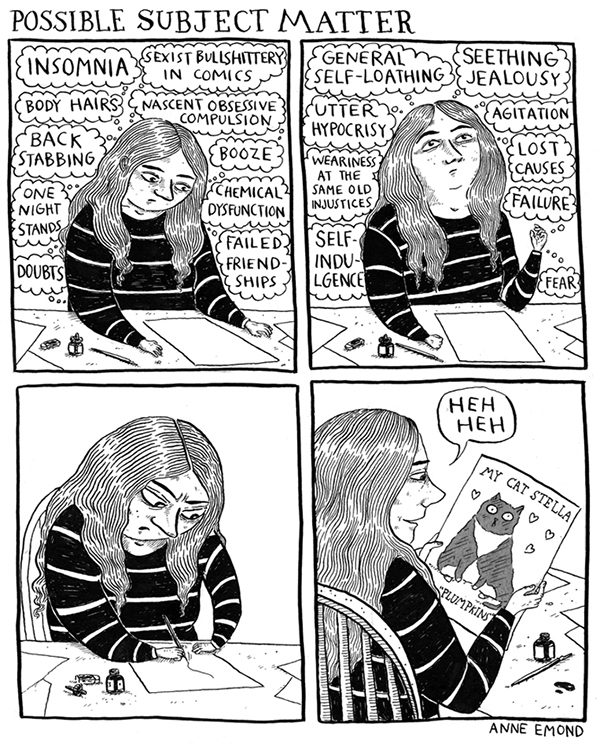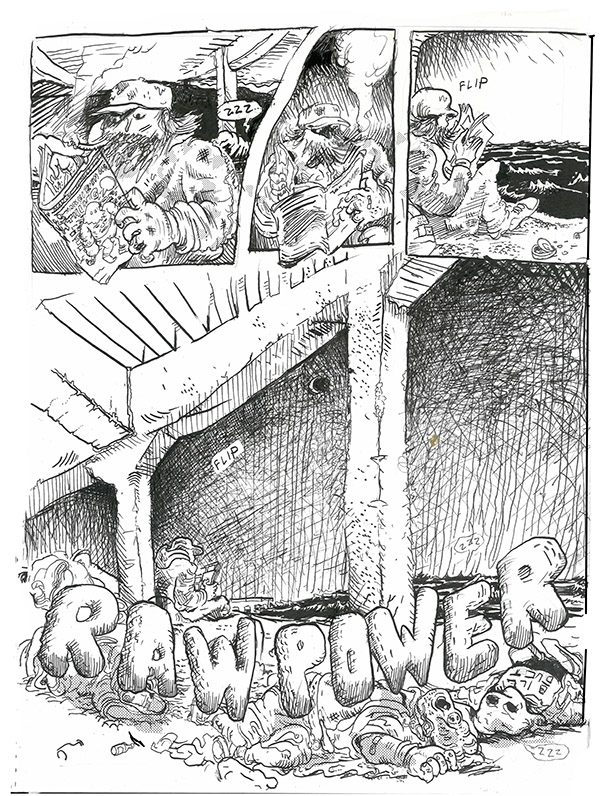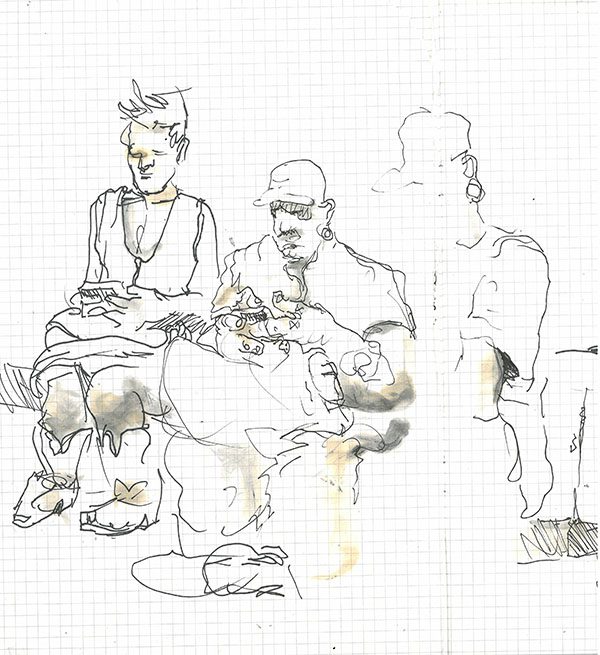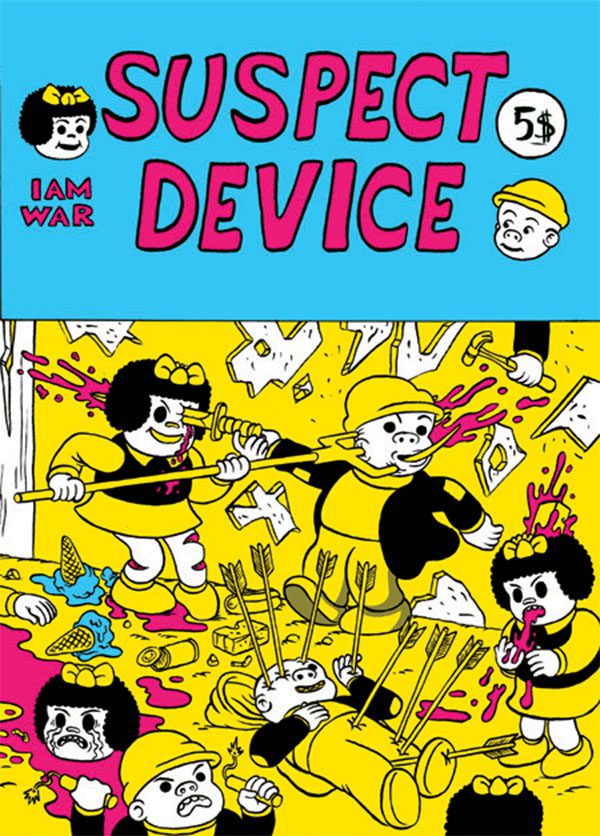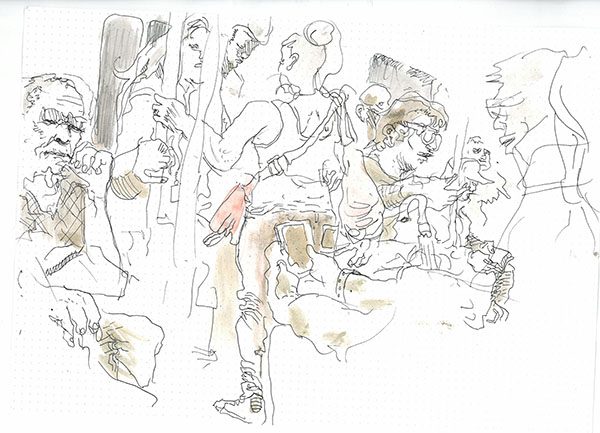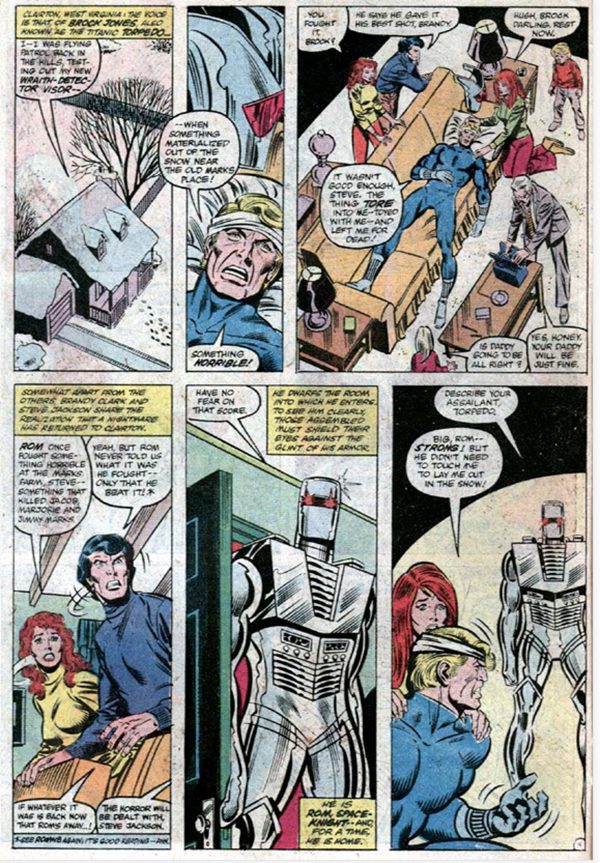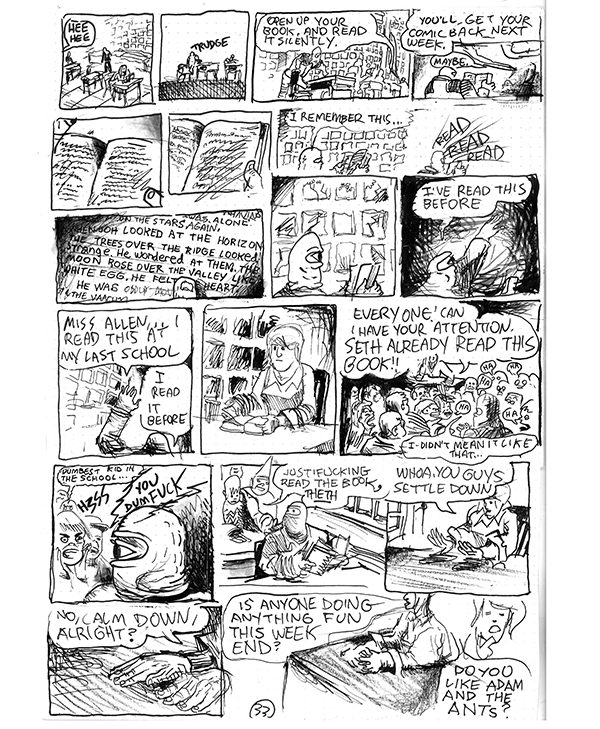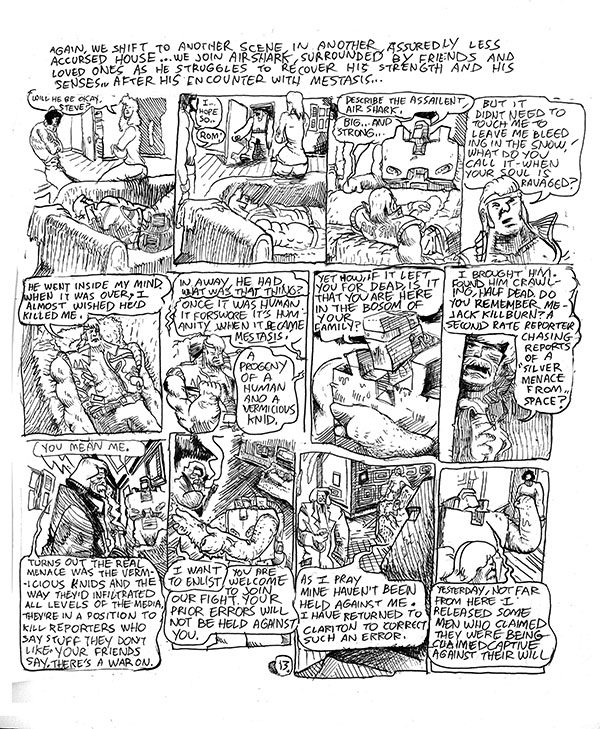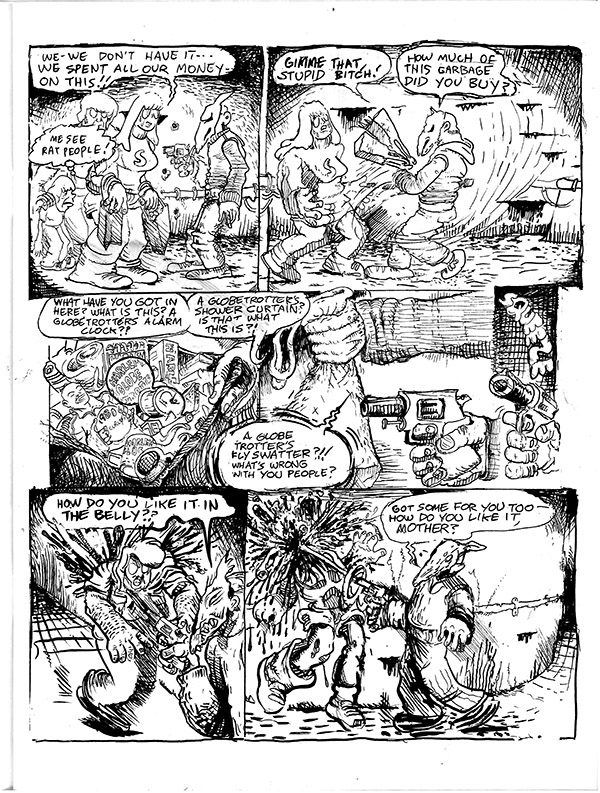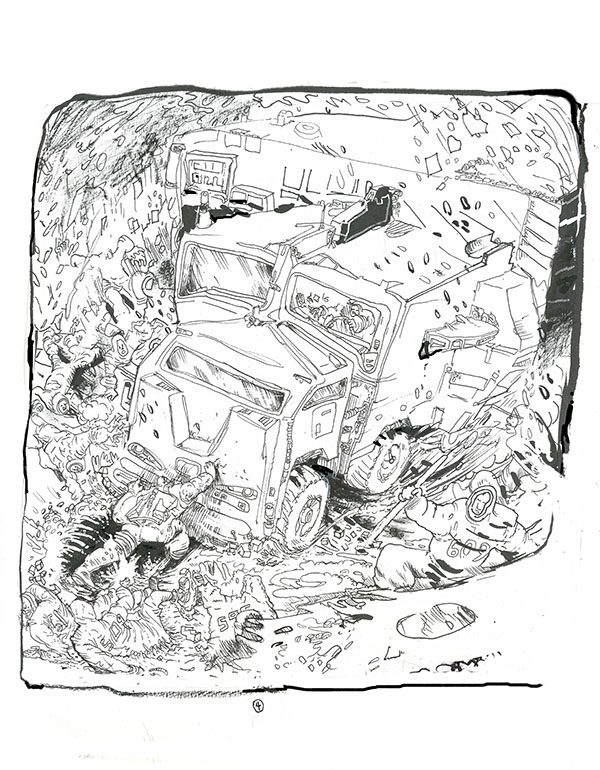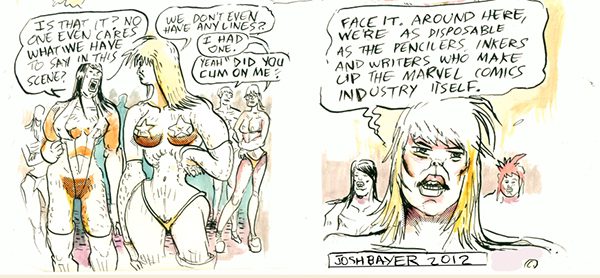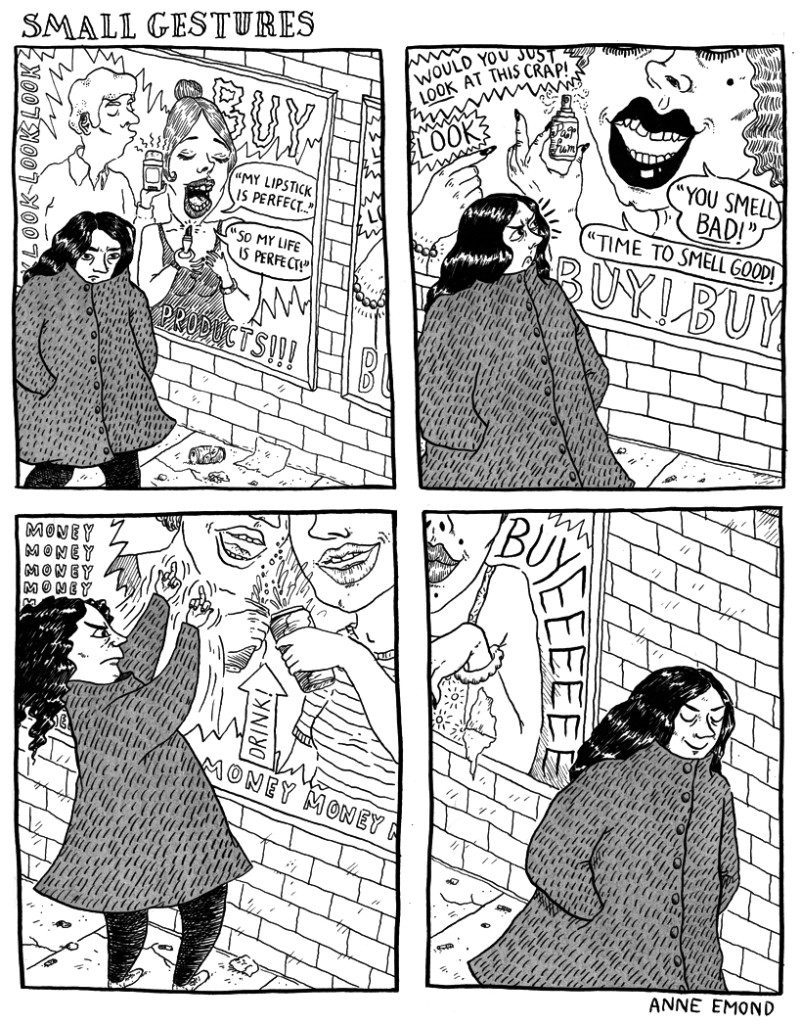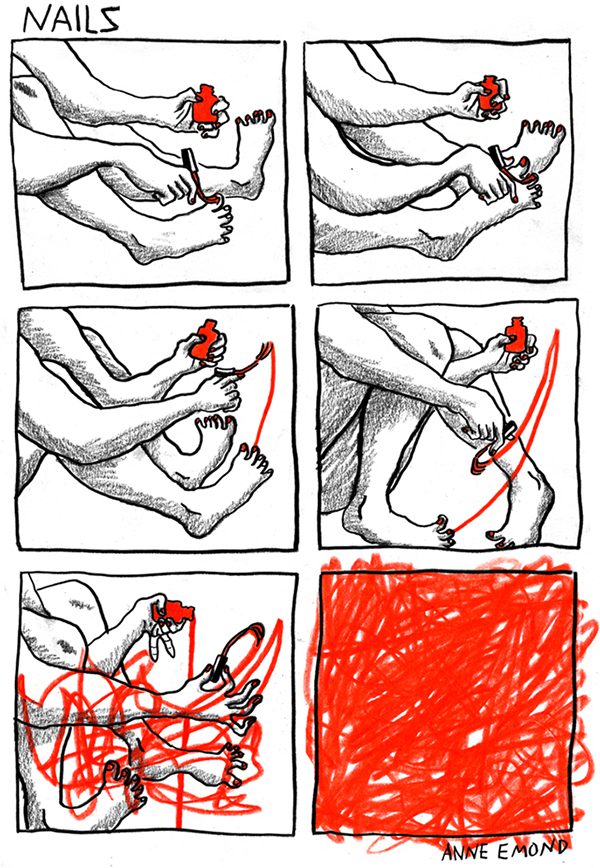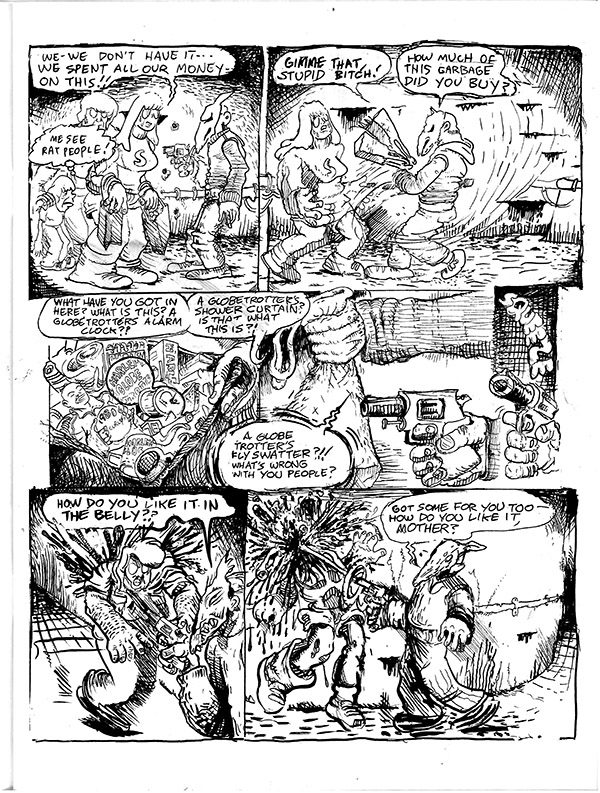The New York Comics & Picture-Story Symposium is a weekly forum for discussing the tradition and future of text/image work. Open to the public, it meets Monday nights at 7-9pm EST in New York City. Presentations vary weekly and include everything from historical topics and technical demonstrations to creators presenting their work. Check out upcoming meetings here.
Last Monday’s symposium brought together two alumni of the MFA Illustration as Visual Essay program at The School of Visual Arts. Josh Bayer was one of the Symposium’s first presenters when it began.
Emond arrived at comics only later in her artistic career. During her time at The School of Visual Arts, she pursued writing and fine art and began work on an illustrated manuscript that she developed for a few months after graduating. It was during that time that she started her renowned Tumblr comics blog to satisfy her hunger for artistic acknowledgement, to showcase the fruits of her art education, and to let off steam.
What started as a side project quickly took over and her personal cartooning adventure began. She noted that the groundwork for practicing cartooning had already been laid in her childhood. One of the books that made the most impact on her was a copy of Barefoot Gen, a Japanese Manga by Keiji Nakazawa based loosely on his experiences as a Hiroshima survivor. She was stunned by how powerfully the autobiographical comic resonated with her as an art form and she learned to appreciate the rawness and immediacy of comics as a medium to express trauma. Emond also recounted the delight of encountering the blunt images of Robert Crumb as a nine-year-old in her father’s bookcase.
Emond’s talk followed her stylistic progression through the past three years of blogging. She emphasized the ways the freedom of creating for the web (with no middle man, client or format in mind) contributed to her artistic education, which she is still undergoing. She attributed the twists and turns in her style to the momentum of producing more and more work almost as much as deliberate stylistic choices.
At first, Emond set aside her preferred technique of nib pens and ink, which she had mastered in school, in favor of Microns. She wanted her comics to remain rough and goofy. She made no commitment to a format and experimented with single panel gags to multi-panel strips and infographics. Occasionally, she avoided narrative altogether and posted atmospheric snapshots.
In terms of content, Emond defines her comics as semi-autobiographical. The scenes she depicts, more so in the earlier years of her blog, are scenes from her daily life in New York City. More recently, the protagonist of her strips has detached herself slightly from the original Anne, and become a “short-haired demon woman.” However, she still represents her moods in a more symbolic way.
Emond confessed that at least one of her goals was to be popular, to be liked. But at first, although widely received, most of the feedback she got from her readers and peers was only about the content: everyone seemed to identify themselves and their own lives with her character. Emond was slightly disappointed that no one addressed her art.
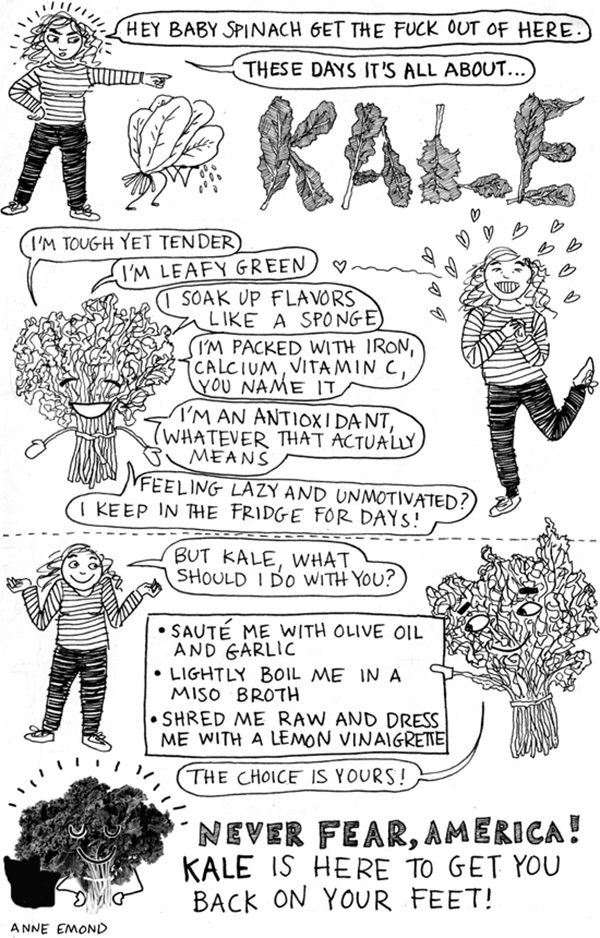
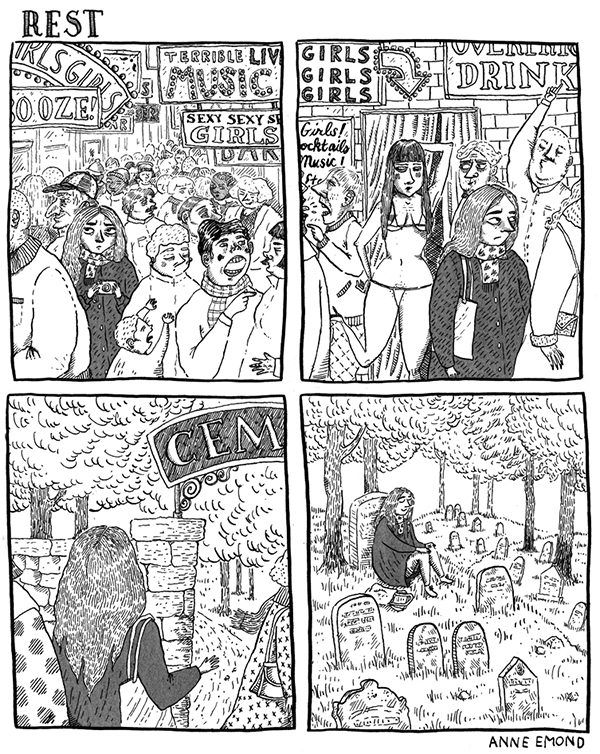
And so, a year or two into posting, she returned to some of the techniques she had mastered in art school. She put more thought into the style she was using while taking note of how her chosen medium would also affect her subject matter. Anne gave an example of a few strips in which her accurate line work and ability to materialize more complex layering of images enabled her to create metaphorical and satirical stories and diverge towards the surreal. She was able to abandon the text because she was able to extract more expression from the drawings themselves by composing the story visually on the page. This was drastically different from her text-heavy earlier strips. Another change was the introduction of color to her semantics.
To this end, Emond also began drawing deliberate inspiration from fine artists like George Grosz and Otto Dix. She described the main challenge of shifting the focus onto her artwork was maintaining the integrity of a comics strip. It wasn’t enough to execute four intriguing, but static illustrations. A comics artist needs to lead the reader’s eye through them so they can be read as panels of a larger, dynamic story. Another challenge Emond mentioned was to be able to narrate the story primarily visually, from within the frame, without resorting to captions. “This way, I have to become more present as a (drawn) narrator,” she said.
In her strip “edgy comics” she addresses her main struggle as a cartoonist: no matter how resolved she is to share the dramas of her personal life and cut deeper into her flesh, this sentiment collides with her complete unwillingness to talk about her life at all. She talked about how squirmy she gets upon reading the strips of her colleagues, marveling at their ability to lay bare the inner most aspects of their personal lives, traumas, and sexual encounters. Every time she posts a comic online, she has her family, co-workers, and her ex-boyfriends in mind. Thinking about the people which inspire her stories inhibits her subject matter.
Josh Bayer took the platform next. In a previous presentation, Bayer gave a comprehensive talk about his artistic influences: Thomas Nast, Mark Mothersbaugh, Philip Guston, and Ernie Bushmiller. But on this night, Bayer focused on how his students have influenced his work as much as his artistic heroes. Like Emond, he was enchanted with comics from an early age, but only took to it after acquiring an extensive education in fine art. Bayer said he had been fighting a voice inside him, which drew him towards and away from the medium until he finally enrolled into graduate school and was able to harness his passion to the traditional techniques of visual storytelling. Nowadays, by teaching the basics of storytelling and page layouts to his young students and by assisting them with their problem-solving process, he continuously makes new discoveries that he applies to his own work. His own prolific creativity is fed by the curiosity of his students as he embraces their rawness, innovation, and unfiltered engagement with the medium.
Josh described his typical daily schedule as the perfect set up for producing work. He always packs a lightweight sketchbook with him so that in between teaching (he teaches at three different schools) he settles down in a donut shop somewhere and draws. After spending the whole day with comics on his mind and tongue, he is saturated with ideas that he pours directly into his sketchbooks. The sketchbooks themselves are a fetish of his and play a big roll in his teachings. He takes his students to museums and asks them to copy from the classics as part of their learning process: to pass the things they see though their own hand and sensibilities and into a material they can hold in their own hand.
As assistant to Professor Tom Hart during his time at The School of Visual Artists, he learned how to approach teaching the medium. The assignments they came up with involved constantly rethinking narratives in classic comics strips by manipulating sequences and contexts, adding and subtracting frames and joining in collaboration to widen the scope of the stories. The constraints of the raw material as a starting point for these exercises open up the imagination. In this context, Josh also mentioned his fascination with Gary Panter’s insistence upon using particular phrases when he teaches his students. “Making marks on a page, NOT lines,” Bayer quoted, “it’s truer to what we leave behind on a page, it better describes the rawness of the experience and sounds more exciting.”
Suspect Device, the popular book Bayer publishes in collaboration with a wide range of artists and his students, was derived from one of Bayer’s earlier teaching assignments.
Bayer took a cue from Scott McCloud’s Five Card Nancy game which consisted of photocopying panels from the classic Ernie Bushmiller strip and rearranging them to create new stories. Bayer gave his students an assignment to fill in the “meat” between two cut up frames of “Nancy” and Garfield. The first issue of Suspect Device came out under the description of Five Card Nancy. It was only later that Bayer had realized his was a unique version of the game, where the artist’s own imagination hijacks the frames into unexpected territory.
Bayer said that the submissions he receives for each issue are ever-surprising and the project is inclusive to both fans and students of comics as well as professional cartoonists. The line between the two categories grows more and more vague.
Bayer concluded his presentation by performing two stories. The first, which he finished just in time for SPX (coming up this weekend) is ROM. Continuing the theme of sampling and appropriation, Bayer’s protagonist, Seth, reads a classic 1980’s Marvel comic about an alien cyborg who fights monsters. Bayer incorporated frame-by-frame redrawings of the original Rom into the pages of his own comic while interpreting in his own stylistic sensibilities and illuminating his own fascination with the classics.
Bayer said his comics aren’t autobiographical necessarily, but are based on his own experiences and cultural inspirations. However, he carefully chooses the experiences he can measure from a distance, in order to maintain an objective perspective and to be able to avoid clenching at content which would disrupt his ability to edit his storytelling in a dynamic and appealing way. “Through cultural pop culture icons one can suggest to autobiography from a safe distance.” Bayer, like Emond, addressed the challenges of depicting traumatic events. While being impactful story material, the main obstacle as an autobiographical cartoonist is the inability to detach oneself from the events in favor of creating a good story (form-wise, not content-wise) and to allow for different tones and shades.
The second story Bayer performed, “The Future is Unwritten,” set in an apocalyptic strip joint peopled by Marvel characters, pays tribute to their “invisible” pencillers, inkers, and writers. Plastic Man appears and confronts Howard the Duck, Deathlok, US Agent, Living Zombie, and Moon Dragon with the fates of their various creators.
An interesting element popped up every now and then as Bayer flipped through the frames of The Future is Unwritten. Due to a miscalculation of the production size, Bayer was left with irregular margin space to fill with small serendipitous sketches.
After the break, Bayer and Emond interviewed each other.
Emond began by asking Bayer to expand upon his fear of corruption by a formal art education. Bayer had dropped out of art school in his late teens, but decided to return to graduate school to reignite his passion. He answered with a Dr. Strangelove metaphor and wrote off his previously stated concern as an impractical need to remain pure and “retain his precious fluids” instead of dealing with the world. Ultimately his education had been incredibly valuable.
Emond was then asked about her relationship to her peers and the cartoonists she wishes to meet. She exclaimed her admiration for Lynda Barry for being one of the few dominant female cartoonists of her generation and for her constant experimentation with mediums of visual storytelling as well as her wonderful writing. Emond also wondered aloud about questions she would ask her: what it would be like to not live in a city like New York, where one has to constantly engage with the world and with survival and what it would be like to be able to throw more of oneself into art and teaching.
In answer to Bayer’s question about the cartoonists Emond had already met, she told him how shy she is at engaging with strangers and that she has rarely attended conventions, returning to the subject of her struggle as a timid autobiographical cartoonist to open up for others to read.
Bayer encouraged her during their conversation to make print versions of her successful web comic and asked her if the reason for her not doing so until this point was her shyness. He described his own agony of putting piles of his failed projects onto the curb for recycling in order to keep moving on, to keep printing and producing new material to overcome these inhibitions.
“Is that why you collaborate with others so much? To break out of creative isolation and loneliness?” Emond asked.
She confessed how hard it would be for her to take responsibility of publishing submissions by other people, which she has no absolute control over, under her own name.
Bayer answered he has had good luck over the years, aside from very few submissions which he deliberated heavily before including them in his anthologies. This is a problem over which he bonded with fellow cartoonists and curators in the same position. “A lot of the material I get is very transgressive because people have a certain idea of what is expected of a Suspect Device comic: big, loud, one-dimensional violence and explicit sex. Maybe it has to do with the need to contradict the exaggerated innocence of the Garfield cartoons and magnify the subtle hints of transgression of a parent-less Nancy. For this next issue I plan to publish all the material that is either too violent or repeated in a separate risograph booklet and I’ll title it Josh Bayer Sucks. Maybe I’ll include nasty pinup cartoons of myself, describing how I sold out to include big shot names in the real anthology and discarded of the masses even though I solicited strips from them. It’ll be Suspect Device Four and a Half and it’ll be a collectors item.”
“It’s too easy to just be gross,” Emond added.
The two discussed their commitment, if any to comics. Bayer’s love for comics stems from it being a much more intimate medium than fine art and how it makes the reader loose sight of his surroundings. It’s a cheap, tactile medium that you can hold in your hands and carry it around wherever you go.
Emond said that while she loves comics, she can’t say she’s entirely committed to it. She celebrates the fact she doesn’t rely on art for her income, so she doesn’t feel obligated in any way to confine herself.
Bayer questioned Emond about her choice to represent herself in an unflattering way. Her comics character is drastically plainer, plumper, and exaggerated than the real-life Anne.
Emond responded by quoting Alison Bechdel from an old interview, explaining that the choice isn’t so much about her own biography, but more to do with comics history. She sees tremendous significance in what one chooses to contribute to the cloud of western visual culture. Women are stereotyped as “babes” too often in our collective visual subconscious and that image diverts the attention from some, if not all of the content. She doesn’t want to put emphasis on the visual aspects of the figure but on her voice.
The two concluded by discussing their process and how to keep true to the inherently raw qualities of the medium. Bayer confessed that he can’t help himself but be raw as soon as he hits the page, finding it hard to hold back and to maintain focus and letting the passion take over.
Emond said she likes the expressive quality of the pencil marks and the freshness of the initial sketch. She is able to maintain that freshness even though she carefully plans her thumbnails and compositions by using a lightbox to ink over her sketches. She uses the thumbnails as a guide to create new marks, rather than simply trace over them. She also keeps the inking and colors in separate layers so she may experiment freely with the layering in Photoshop.
List of Images:
Image 1-11: Anne Emond, Comiques.com, 2010-2013
Image 12: Josh Bayer, Raw Power #2
Image 13: Josh Bayer, 2013
Image 14: Student work
Image 15: Jon Vermilea, Suspect Device, 2011
Image 16: Josh Bayer, 2013
Image 17: Sal Buscema, Joe Sinnot, Rom, Marvel Comics, 1980
Image 18-21: Josh Bayer, Rom , 2013
Image 22-23: Josh Bayer, The Future is Unwritten
Image 24-25: Anne Emond, Comiques.com 2010-2013
Image 26: Josh Bayer, Rom, 2013
About the author: Keren Katz is the illustrating half of the Katz Sisters duo. She is also the half that is not fictitious. Their latest graphic novels are “Jospeh and his Amazing Technicolor Coat Check Dream” and “The Night Poetry Class in Room 1001.”You can check out more of her projects here.

